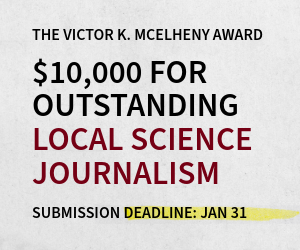One day in my new job at Pacific Northwest National Lab, a colleague and I went to one of our climate scientists to grill him. He was going to be interviewed live on a radio webcast, and we wanted to make sure he'd be understandable to people who aren't researchers. Well, he beat us to the punch. He'd already uncovered a short article about talking about climate change in Eos, the American Geophysical Union's weekly newspaper.
by Mary Beckman
One day in my new job at Pacific Northwest National Lab, a colleague and I went to one of our climate scientists to grill him. He was going to be interviewed live on a radio webcast, and we wanted to make sure he'd be understandable to people who aren't researchers. Well, he beat us to the punch. He'd already uncovered a short article about talking about climate change in Eos, the American Geophysical Union's weekly newspaper.
The author, Susan Joy Hassol, is a self-described climate change communicator. She helps large groups of scientists write reports on various aspects of climate change. She wrote the article "after many years of working with scientists and coming up against the same issues and seeing the same mistakes made over and over." It is chock full of good information.
One reason her article stands out is that she gives many concrete examples of how certain words mean different things to scientists and the public. She says she has a much longer list, but it has yet to find a home.
I couldn't help but be amused at a couple of Hassol's examples. Aerosols, for one — tiny particles in the atmosphere. We've got a big atmospheric aerosol contingent up here, so I've been hearing the word a lot this past year. The public (and I, regardless of how much the scientists try to train me) think "spray can" when they hear it.
Unfortunately, climate change is no chuckling matter, and coverage of it by journalists is only going to rise with the concentration of carbon dioxide in the atmosphere. She offers a couple metaphors scientists can use — they certainly helped me with my constant struggle of keeping "weather" and "climate" straight. For example, we can't predict when any particular person will die (weather), but we can be sure of the average age of death (climate). Or put a pot of water on to boil: we can't predict when and where the bubbles will form (weather), but we can be sure the water will be boiling in about 10 minutes (climate).
Climate change research suffers from political baggage more so than many scientific fields. One of the concerns scientists have when speaking to the public (as well as journalists) is that they don't want to sound like advocates.
To avoid that, Hassol says she tells them to put statements in an if-then format. "Don't say we should cut emissions by 80 percent. Do say, if we stay the current course, this is what's going to happen." In that way, scientists are informing policy. Like the president's science advisor Harold Varmus told Jon Stewart recently, "These are things that scientists can help with. We don't make the policy. We don't pass the bills."
And scientists love to throw in their caveats, which Hassol says just confuses everyone. "If we do too much qualifying, we end up sounding like we don't know anything," she says.
Her article has generated quite a few positive responses from scientists, she says, including letters written to Eos' editorial page. Of course, there is always one scientist who thinks communication between the science world and the real world is just fine. One letter to the editor pointed out that because "anthropogenic" has made it into media coverage, "virtually everyone now understands what it means". Next time you're on an airplane, ask the person sitting next to you for the definition.
As with any research, media can play a role in educating the public about the scientific issues. But Hassol thinks educating scientists about the English issue is just as important.
"It's too big a job to think we can educate the lay public on science terms," she says. "Isn't it easier to educate scientists on different ways to communicate to the public? Scientists are a much smaller group — it seems to me much more doable."
So when my climate researcher explained that the reason trees won't be able to adapt to a changing climate as easily as people will was because trees don't "migrate" as fast, and I responded with a smartaleck, "Of course they can't migrate. They have roots," I like to think I was just doing my part.
Hassol's article, "Improving How Scientists Communicate About Climate Change," is posted on her website.
Mary Beckman is a senior science writer at the Pacific Northwest National Laboratory.
(NASW members can read the rest of the Spring 2009 ScienceWriters by logging into the members area.)



